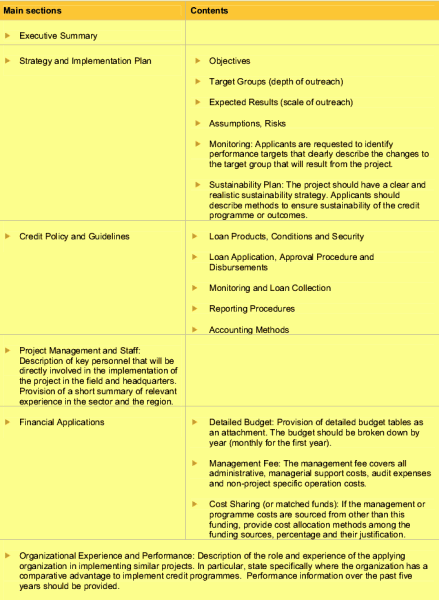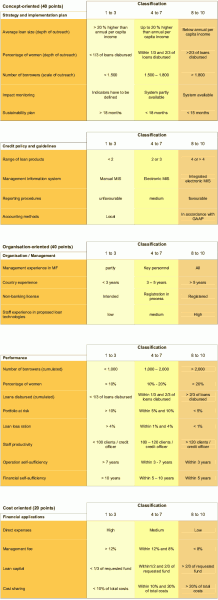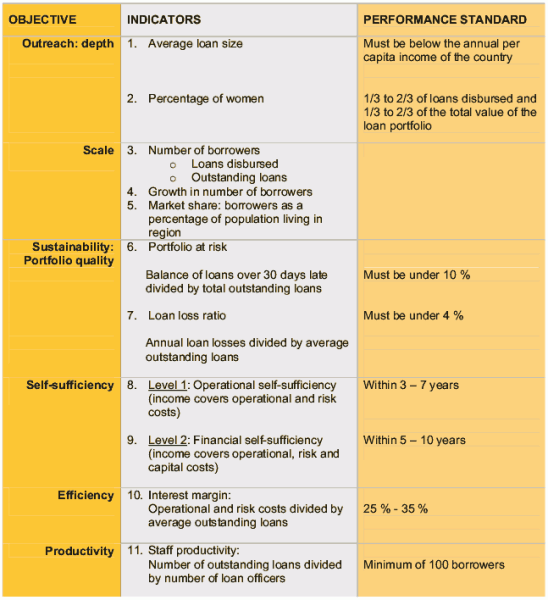|

|
Introduction
The successful establishment of a Credit Programme is dependent upon a number of key variables, including:
- Adequate infrastructure, skilled entrepreneurs, access to information, and a credit culture conducive to micro enterprises;
- Qualified management of the intermediary (credit organization) and well-trained human resources;
- Sufficient number of clients / beneficiaries;
- Urban or rural setting or combination of both;
- Proper credit products and conditions appropriate for the preferences of the target group (micro / small enterprises, agricultural enterprises);
- Efficient and streamlined operations to keep costs low;
- Motivated clients to repay the loans;
- Market-oriented interest rates and fees;
- Strategic planning for viability and sustainability;
- Efficient risk management;
- Cooperation with other agencies to provide add-on services;
- Government agreements or legislation conducive to MF organizations
- Financial oversight by central banks
The following ten-step procedure describes the most important elements that need to be addressed when developing a credit programme.
Step 1: Preliminary appraisal
The preliminary appraisal should analyse the economic conditions in the market areas, market chains, local business cycles and rural seasonal activities, and assess the overall need/demand for (micro-) finance services. The appraisal must address the following questions:
- What financial services exist in the region? What types of credit are currently available or have been in the past?
- What economic activities serve as the basis for the local economy (e.g. non-agricultural activities, agricultural activities?)
- Is the borrowing and savings capacity of the target groups sufficient? What is the local repayment capacity?
- What is the potential volume of borrowing related to the target groups?
Step 2: Identification of potential intermediaries
Suitable professional intermediaries must be identified and selected to implement and manage donor-supported credit programmes. Possible intermediaries to implement credit programmes are:
- Commercial banks;
- Micro-finance institutes;
- Financially-oriented NGOs;
- Savings and credit cooperatives;
- Financial self-help groups.
|
|

|
Step 3: Pre-selection of potential intermediaries
Determine whether the credit policies and financial technologies of potential intermediaries correspond to the target groups’ needs and clarify the interest of potential intermediaries in credit programme implementation.
Intermediaries must be capable of providing sustainable services to expanding number of borrowers. Therefore, they should have the following qualifications:
- Competence and experience in basic lending operations;
- Commitment to serving poorer clients, both women and men;
- Orientated toward outreach and sustainability;
- Concentration on client needs and close geographic and social proximity to borrowers;
- Legal and managerial autonomy (free from political influence);
- Effective and efficient management;
- Competent and motivated personnel with low staff fluctuation;
- Performance based salary structures for staff and management;
- Willingness to adapt new financial technologies and products;
- Cost-conscious organizational and operational structures;
- Well-functioning management information system and effective accounting system;
- Financial and annual reports in keeping with international standards;
- Regular external audits with an annual attestation by independent auditors.
The credit product available to the target groups is designed by the intermediaries. The range of the intermediaries’ available credit products, and their orientation toward the target groups is one of the selection criteria. The available credit products are an important part of the proposal.
Step 4: Organisation of a closed tender
Prepare a Request for Proposal (RFP) and invite pre-selected intermediaries to participate in the tender.
The RFP includes background information, statement of purpose, objectives, request for proposal with contact data and the applications guidelines. An application guideline which includes the elements to be covered in the proposal, is depicted in table 1.
Table 1: Application Guidelines for Intermediaries (Credit Organizations)

Step 5: Selection of the most appropriate proposal
The final selection of the intermediary is made after a thorough assessment of the submitted proposals according to defined criteria.
Examples of criteria and their assigned weight in assessing proposals are shown in table 2.
Table 2: Example criteria for assessing credit proposals

|
 |
Step 6: Negotiation of financing agreement
The transfer of a credit fund to the selected intermediary should be regulated by a financial agreement. Based on the proposal and final negotiations, the agreement should specify the amount and purpose of the financial contribution, disbursement procedures, termination and duties of the intermediary, the specific target groups, the financial technologies utilized, and the required performance standards.
To ensure that the credit fund is managed efficiently, grants for institution-building measures and operational costs may be needed and are part of the financial agreement. Grants to help cover operational costs may be prudent at the start-up or expansion phase of a financial institution, but they must be subject to a clearly-defined time limit and gradually eliminated as business volume expands.
Step 7: Supervision and monitoring
Effective supervision and monitoring of credit programme management should be based on the performance standards outlined in table 3. The intermediary should be obliged to submit regular reports. When performance standards are not met, the causes should be immediately determined and suitable remedial action undertaken .
Step 8: Start of credit programme
The intermediary mobilises potential clients, informs the target groups about credit products and conditions, and initiates lending procedures according to the intermediary’s operational manual.
The range of credit products and conditions should respond to demand from clients operating different types of businesses with different capital requirements, such as:
- Credit Group Loans: designed for new clients with modest levels of business activity and cash flow;
- Progressive Group Loans: in response to clients with larger capital needs, especially working capital needs;
- Small Enterprise Loans: in response to improved market conditions and un-met demand. The Small Enterprise Loan should serve clients who may succeed in expanding their businesses beyond the services available through group lending products, but who may not yet be ready to approach commercial banks for credit;
- Rural Loan Products: supporting the delivery of financial services to rural communities engaged in crop planting, animal husbandry, market gardening, dairy production, other processing activities, and trade in rural produce.
Table 3: Suggested minimum requirements: performance standards

|
 |
Step 9: Evaluation of the impact
After a credit cycle is completed, an external party evaluates the impact of the credits on the business level as well as on the household level. Typical questions could be:
- After taking credit, did your income increase/decrease?
- What, if any, improvement did you experience in your business activity?
- Were new jobs created as a result of business expansion?
- What, if any, improvements of the conditions of the family did you experience?
Step 10: Monitoring and evaluation of the intermediary
The intermediary is monitored and evaluated regularly as described in 8 above
|





